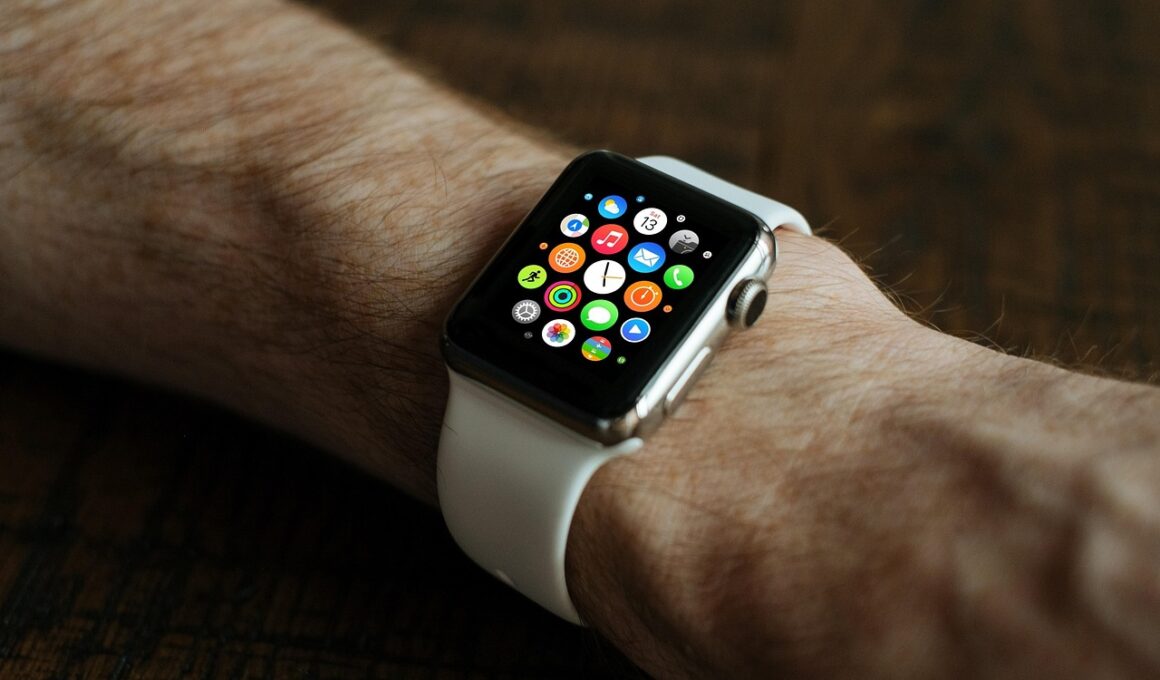Using Wearable Technology to Track Your Weight and Fitness Levels
In an age where technology permeates every aspect of our lives, wearable technology has emerged as a significant tool for weight maintenance. These devices, ranging from fitness trackers to smartwatches, provide critical insights into your day-to-day physical activities and overall health. By accurately tracking your weight, exercise routines, and even sleep patterns, these gadgets offer an integrated approach to fitness management. Wearable technology not only facilitates a better understanding of your body but also promotes consistent engagement with your fitness goals. Users can monitor their calories burned, heart rate, and more through real-time data. This means you’re informed with actionable insights, enabling you to make wiser health choices throughout your day. Additionally, many wearable devices link to mobile apps that help you visualize your progress over time, motivating you further on your weight maintenance journey. Thus, the integration of wearable tech in your lifestyle enhances your ability to stay fit and healthy. As individuals become more accountable for their wellness, the impact of these tracking tools in weight management becomes profoundly evident.
Benefits of Using Wearable Devices
One of the primary benefits of employing wearable devices is their convenience and accessibility. Unlike traditional fitness monitoring methods, using wearables offers immediate feedback on your physical activity levels. This technology keeps you accountable, as it constantly reminds you of your daily fitness requirements, making it easier to stick to your goals. Furthermore, these devices often come equipped with additional features, including exercise reminders and personalized workout plans tailored to your fitness level. Many wearables now have advanced analytics capabilities, which process data points, allowing users to input specific goals and track their progress effortlessly. This powerful feedback loop encourages continuous improvement and fosters healthy habits over time. Another notable advantage is their compatibility with various mobile applications, which can aggregate data from multiple sources, giving a more holistic view of your health situation. Consequently, it becomes simpler to spot trends and identify areas for improvement. Overall, wearable technology serves as a comprehensive solution for anyone seeking to monitor their weight and fitness levels while enjoying ease of use and effectiveness in achieving wellness objectives.
Wearable technology further benefits users through the provision of data-driven results. The accuracy of the information collected, such as steps taken, calories burnt, and heart rate variances, allows individuals to make informed decisions regarding their fitness plans. For instance, if your wearable indicates insufficient daily activity, you can make adjustments promptly to incorporate more exercise. Many popular wearables also allow for customization in settings, meaning you can prioritize specific metrics that align with your weight maintenance goals. Moreover, social connectivity features provide avenues for sharing your achievements with friends or online communities, thus driving motivation through camaraderie and accountability. As a result, the integration of social aspects offers community engagement that can be crucial for maintaining motivation longer-term. Furthermore, users can participate in challenges fostering competition and companionship, which not only improve fitness levels but also enhance personal relationships. By facilitating these connections, wearable tech generates impulses to maintain a healthy lifestyle and create sustainable fitness habits. Thus, the positive feedback provided through social sharing, together with personalized data analytics, can significantly amplify motivation and adherence to fitness routines.
Challenges and Considerations
Despite the numerous advantages of wearable technology, there are inherent challenges associated with their use. One of the major difficulties involves user accuracy and the potential for over-reliance on technology for motivation. While these devices can provide substantial information, they may also create a false sense of security, leading users to neglect basic health principles and encouraging excessive exercise or unhealthy dieting behaviors. Establishing a balanced relationship with technology is vital to prevent detrimental habits. Furthermore, privacy concerns regarding data security can arise from sharing personal health information with applications. Users should be aware of how their data is stored, shared, and utilized by third parties. This highlights the importance of choosing reputable brands that prioritize user privacy. Additionally, some may find wearable technology cumbersome or uncomfortable, potentially inhibiting their active use. Thus, it is crucial to select devices that not only meet your tracking needs but also fit comfortably into your daily routine. Ultimately, recognizing these challenges can help individuals take proactive steps in maximizing the benefits of wearable technology while minimizing any risks involved.
To ensure a successful weight maintenance journey, it’s essential to set realistic goals and track your progress using your wearable device. Establishing clear, achievable objectives can aid in monitoring your journey effectively and keeping you motivated. For example, aim for specific weight loss or fitness milestones rather than vague objectives. Clear targets facilitate focused efforts and allow for adjustments in your workout routine and diet based on feedback from your device. Regularly reviewing your data can reveal trends that indicate when changes might be necessary. Choosing to connect your wearable with other fitness apps can help streamline efforts, consolidating the information for enhanced tracking. This can lead to a well-rounded assessment of your fitness journey by comparing metrics from multiple platforms. Additionally, engaging with online forums or communities supportive of your weight maintenance efforts can offer encouragement and shared experiences for insight. Seeking guidance from fitness professionals can also provide personalized recommendations that leverage your wearable to its fullest potential. This combination of strategies can lead to long-term success in maintaining weight and achieving optimal health.
Future Innovations in Wearable Technology
As technology evolves, the field of wearable devices is expected to advance significantly, further enriching your weight maintenance experience. Future innovations could include improved sensors that provide even more precise health metrics, such as blood sugar levels or hydration status. This level of accuracy may enable users to gain a comprehensive understanding of their body functions. Additionally, developments in artificial intelligence could allow wearables to learn from user patterns and offer tailored advice based on individual behavior and preferences, enhancing overall user experience. Another exciting prospect involves the integration of virtual reality or augmented reality with wearable technology, potentially creating immersive training environments. These innovations would not only enhance fitness experiences but also transform motivation levels by making workout routines more engaging. Furthermore, improvements in battery life and device affordability will promote accessibility, ensuring that more individuals can benefit from tracking their fitness levels without financial constraints. As a result, the future of wearable tech in weight maintenance looks promising, ushering in a new era of health management that prioritizes personalization and user engagement in maintaining fitness.
In conclusion, wearable technology represents a revolutionary tool for weight maintenance and fitness monitoring. By providing critical insights into user activity and health metrics, these devices equip individuals with the necessary tools to make informed choices regarding their well-being. The ability to monitor progress, set achievable goals, and share experiences with communities can significantly amplify motivation and adherence. Nevertheless, it is essential to navigate the challenges associated with technology and remain mindful of establishing a balanced relationship with data. As wearable tech continues to evolve, users can expect more personalized experiences and innovative features that will further enhance weight management strategies. Users should actively engage with newer wearable developments, as staying informed allows for optimized health management. By combining these technologies with supportive habits and professional guidance, individuals can establish sustainable fitness practices conducive to a healthy lifestyle. Therefore, understanding the complexities and opportunities of wearable devices can empower users to take control of their health, effectively facilitating their fitness journeys. Embracing these advancements enables a proactive approach to well-being and creates a culture of accountability in maintaining weight and fitness levels.


